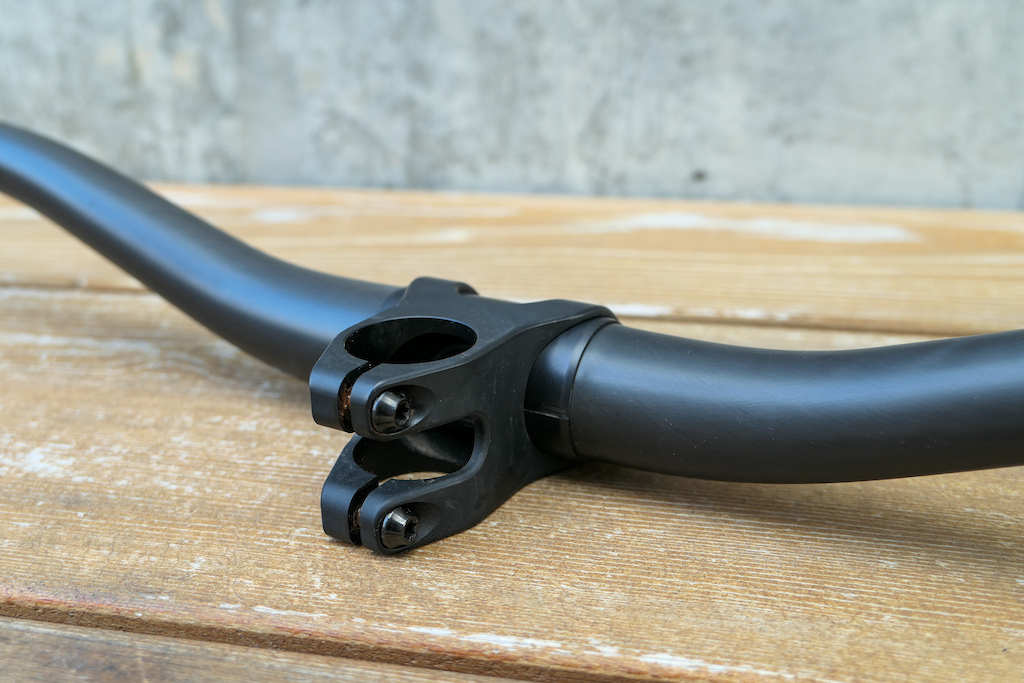
In this test are just three of the many unique handlebars on the market, but each one has its own spin on the tuned carbon layers; We Are One Composites’ Da Package bar and stem combo, the Title Form 35 Carbon, and OneUp Components’ aptly named Carbon Bar.
There’s more to be gained from riding carbon bars than just saving a few grams and flashing up your bike. Although not all carbon bars are made equally, they can be engineered in such ways to allow for a lot or little flex.
Vibration absorption too is a huge selling point. Compared to alloy bars, which tend to all feel similar, carbon tends to damp the feedback much differently than the ring of aluminum. That’s not true for every carbon bar out there though. It shouldn’t be confused with flex either. Alloy bars can flex plenty yet still without taking the sting out of your hands.
Each bar was used on the same bike, with the same wheels at one point or another, and was cut to a 765 or 770mm width.
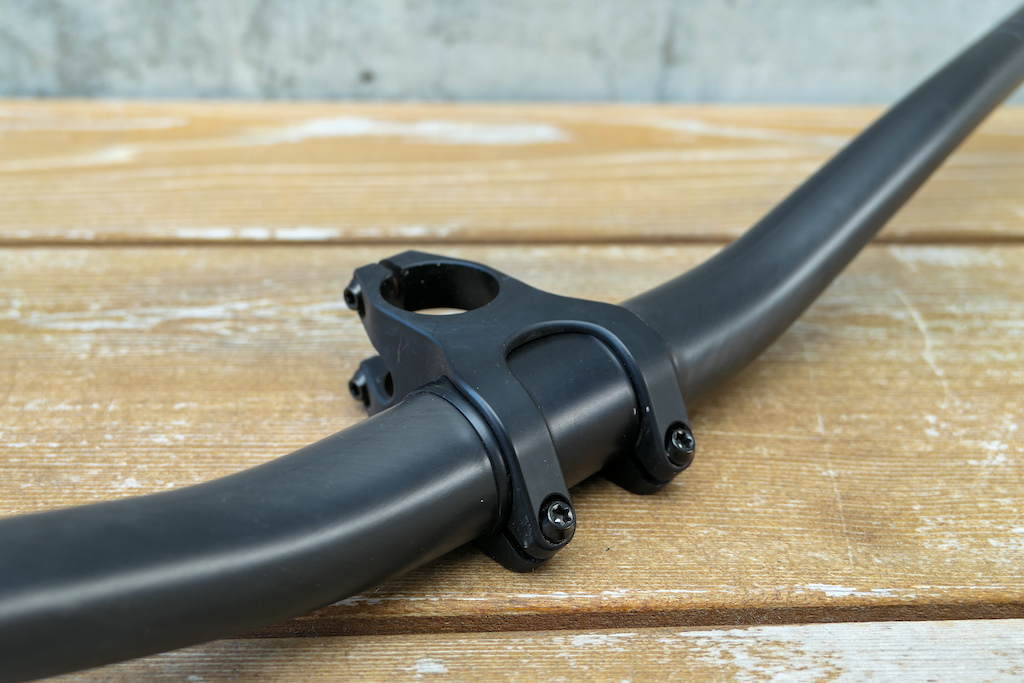
We Are One Composites Da Bar (and Da Package)
Together, their carbon bar and 7075 alloy stem make up Da Package. Da Stem can be used with any standard 35mm handlebar (provided it can slip through the two-bolt design) because Da Bar is actually 33mm in diameter. In order to fill the gap, an aluminum sleeve wraps around the carbon bar to alleviate clamping forces. Due to the concept of the aluminum sleeve, Da Stem is the only compatible mate for this handlebar.
• 35mm clamp diameter* (w/ proprietary sleeve)
• 20, 27.5, 35mm rise x 800mm width
• 8° backsweep 5° upsweep
• Weight: 252g (35mm at 770mm)
• Colors: raw finish
• MSRP: $260 USD / $325 CAD
• weareonecomposites.com
Throughout testing other carbon handlebars on the market, the team at We Are One Composites found competitors’ products to have a large number of inconsistencies in the clamping surfaces, compaction, and layering. That led to the two critical design philosophies: uniformly placed carbon layers that flex equally at either end of the bar, and an aluminum sleeve sandwiched under the stem to distribute forces that bite down on the carbon tube.
This bar flies under the radar with zero logos, paint, or etchings. What makes Da Bar stand out further is the raw carbon finish. Like their carbon rims, the finished product comes straight out of the oven without any filler to hide blemishes.
Hand-laid and tested in their Kamloops factory, Da Bar exceeded their in-house EFBE testing by 25% over the required forces for gravity riding. Although there’s no direct mount stem option, that makes it “downhill rated”. As with all We Are One Composites products, Da Bar is covered by a lifetime warranty for the original owner.
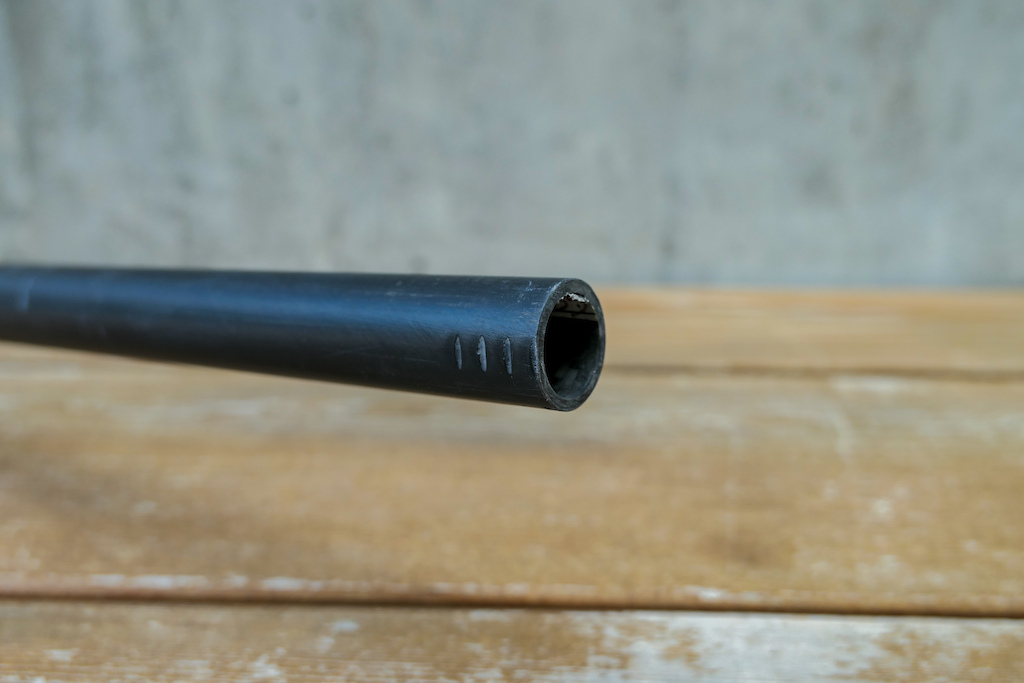

Specifications
Da Package isn’t short on setup options, though. Da Bars come in 20, 27.5, or 35m rises, are 800mm wide and can be cut down to 740mm. There is either a 35 or 45mm stem length choice, however a matte black anodized finish to match the stealth bar is the sole option.
When looking down at the bends in the Da Bar, they appear to be slightly abnormal but are given a common 5° up and 8° back-sweep. There are no gradients marked on the stem or bar, so a tick from a felt marker is a subtle way to keep track of your preferred rotation.
As for the torque specs, the stem to bar should be tightened to 4.5 and 6.5Nm at the steer tube via the titanium torx bolts. Handlebar control clamps are advised to be torqued to the manufacturer’s specifications.
Price and Weight
As far as pricing goes, We Are One only sells Da Package as a combo which costs $260 USD / $325 CAD.
The bar we tested was cut to 770mm and weighed 252g while the 35mm-length stem was 80g, making it slightly heavier than the claimed 332g number of the uncut combo.
Ride Impressions
While some riding peers claim that they can’t feel a difference between handlebars, I have no doubt that even an intermediate rider could distinguish Da Bar from an ultra-stiff handlebar in a back-to-back test. Da Bar is one of the softest handlebars I’ve tried to date.
There’s no denying that Da Bar is comfortable on relentless descents and chattery trails. Vertical compliance is ample. This can take the sting off g-outs and harsh hits that can overwhelm short-travel bikes. However, on a few different enduro bikes, and even an eMTB, the amount of movement stood out considerably.
Da Bar does stand out as one of the more compliant components on those style of bikes. I’m not saying there’s anything wrong with that, but I’d prefer to trade off some comfort for control on anything more than a traditional trail bike.
In terms of angles, I got on well with the 8 and 5-degree bends across the variety of bikes Da Package was tested on. For bikes with head tube angles steeper than 65 degrees, I might be looking for a stem length longer than 45mm to slow down the steering inputs. At the moment, there’s only a 35 or 45mm-length stem choice when it comes to Da Package.
The only performance woe that I experienced was some rotation from the ODI Lock-On grips. In order to prevent this, I needed to tighten down the single-bolt clamp to the point where I thought it might strip (5Nm).
+ Softer flex is ultra comfortable, especially on short travel bikes.
+ Aluminum sleeve reduces stress around stem clamping surface.
+ Exposed carbon finish leaves no room to hide manufacturing errors.
+ In-house testing exceeded EFBE Category 5 Gravity-rating.
– Flex may be too soft for larger riders or those who prefer a full 800mm wide bar.
– Lock-on grips may need to be torqued higher than expected.
– Proprietary clamping surface is clever but comes at a higher price point (Da Stem required).
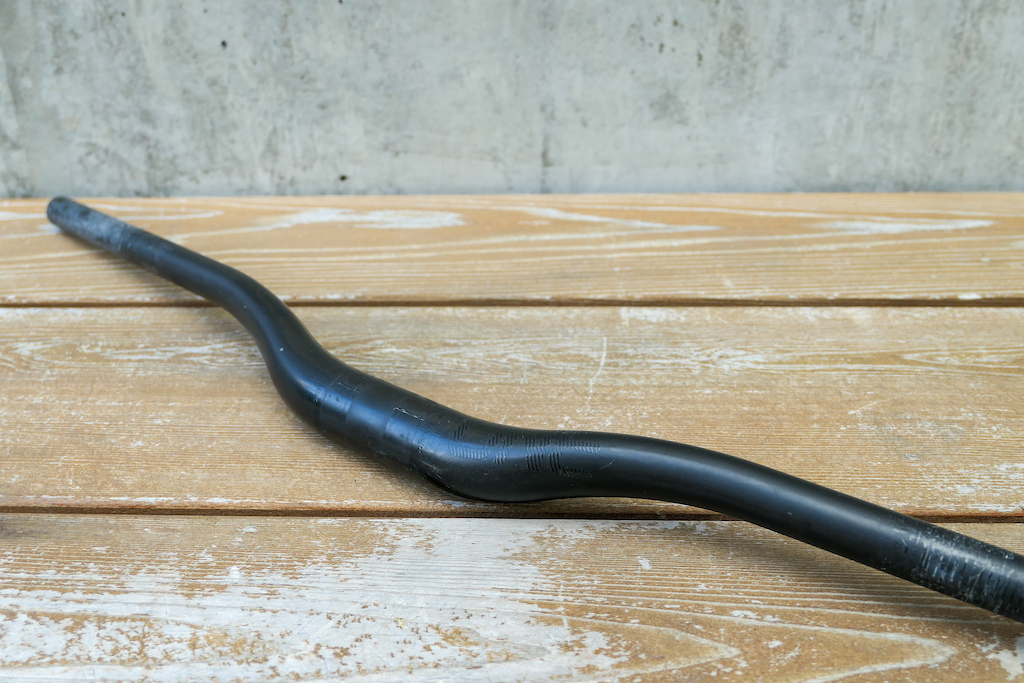
OneUp Components Carbon Handlebar
It’s also clear that OneUp believes in the strength of their design since it passed the stringent EFBE TRI-Test. The 35mm diameter Carbon Handlebar also features a rotational gradient which is said to relate directly to the head angle. Instead of basic reference guidelines, head angles of 62 and 66 degrees are listed.
• 20 or 35mm rise x 800mm width
• 8° backsweep 5° upsweep
• Weight: 233g (35mm rise at 765mm width)
• Colors: raw finish
• MSRP: $159.50 USD / $199.50 CAD
• oneupcomponents.com
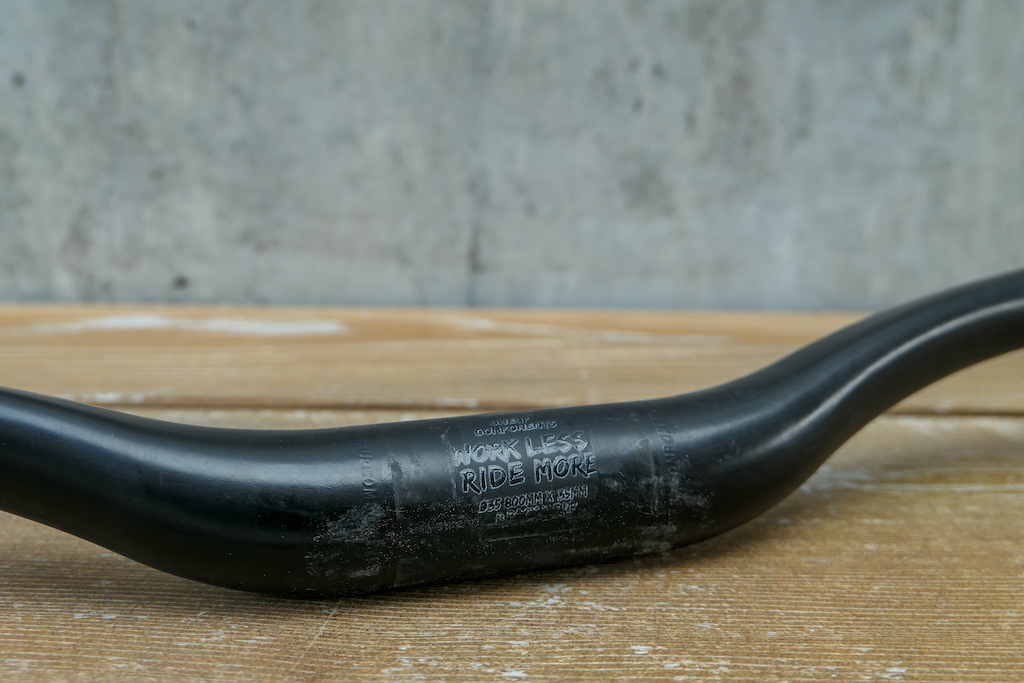
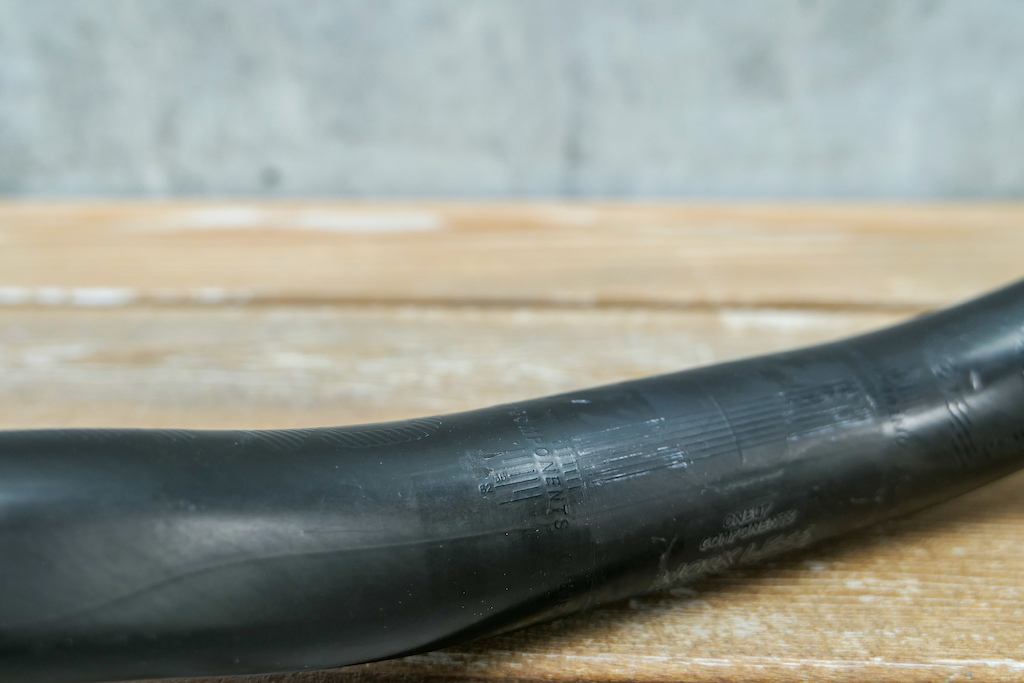
Specifications
The Carbon Handlebar comes in two rises; 20 or 35mm and just one basic black finish, but sticker kits are available for customization. Uncut, the bar measures 800mm wide with 5 degrees of upsweep and 8 for backsweep.
Singular clamp grips must be installed with the collar on the inboard side. No, you can’t use your old bar ends from the 90’s with this bar. There’s also a maximum stem clamp width of 65mm and a minimum trim width of 740mm.
The listed torque specs are 6Nm for the stem face plate clamping force and 5Nm for handlebar controls. It’s worth noting that their stem requires the upper face plate bolts to be torqued first, then the bottom set.
Price and Weight
A standout number surrounding the OneUp Carbon Bar is the price tag. $159.50 USD makes it one of, if not, the most affordable carbon bars on the market. That’s backed by a one-year warranty against manufacturing defects.
On our scale, the 35mm rise Carbon Handlebar weighed 233g after being trimmed to 765mm. That’s a touch heavier than the claimed 225g measured at full length.
Ride Impressions
Before diving into the characteristics of this bar, let it be known that this handlebar has been through the wringer. It has served as my go-to when a test bike arrives with stock equipment that I don’t get along with. That means it has been subjected to frequently adjusted bar controls, brake bleeds, plus plenty of off-trail excursions and the usual shuttle damage.
With that said, the finish is showing its age after more than a season of abuse. The gradient markings are starting to peel in places. I found that changing the roll depended on the size of the test bike and my preferred stack height, so this feature wasn’t crucial for my setup preferences.
Like the We Are One Da Bar though, I did notice the need to clamp most grip collars tighter than expected. The grip clamp torque did fall within the given range of 4Nm though.
Overall, the OneUp Carbon Handlebar remains one of my favorites due to the angles and soft, but not overly flexy feel. There’s a certain way that this bar seems to swallow up vibrations that are otherwise passed along by alloy handlebars.
+ Flex and feedback is on the comfortable side without feeling vague.
+ Good price for a carbon handlebar.
+ EFBE TRI-Tested.
– Finish can peel over time.
– Rotational gradient should be taken lightly.
– Clamping surface is not compatible with all direct mount stems.
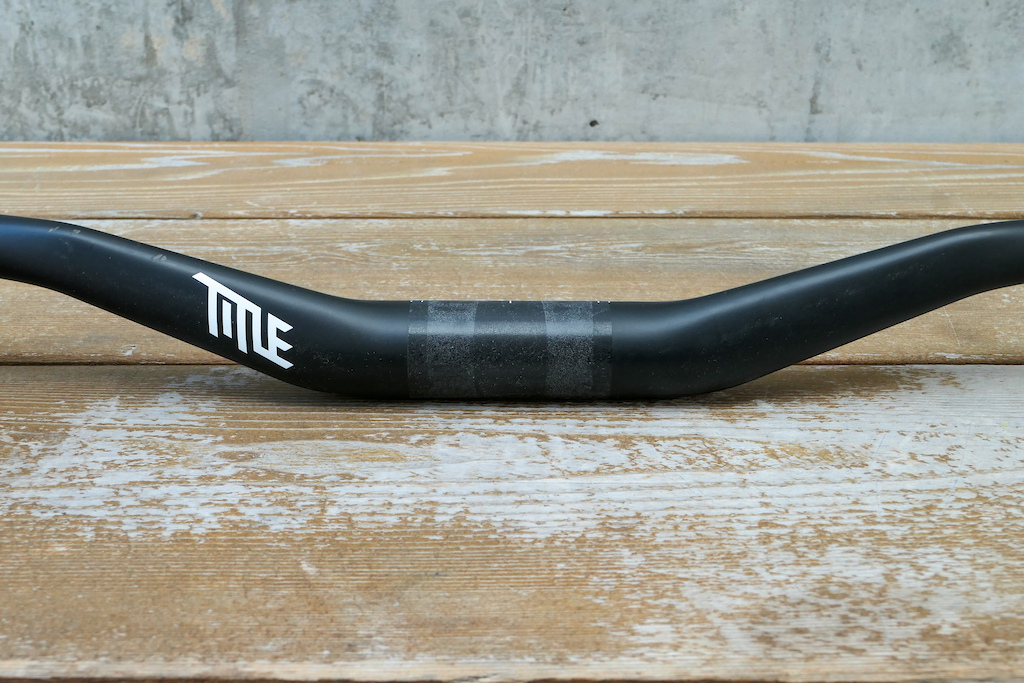
Title Form 35 Carbon
Despite this shape Title MTB states that their Form 35 Carbon is engineered to retain stiffness in the steering plane, but remain vertically compliant – Title claims that the Form 35 bar is one the softest on the market. The Form 35 Carbon was also TRI-Tested by EFBE and given a Category 5 rating, making it more than suitable for downhill riding.
• 35mm clamp diameter
• 87mm clamp width (Compatible with DM1)
• 9° backsweep 5° upsweep
• Colors: matte black finish
• MSRP: $213.00 USD / $279.95 CAD
• titlemtb.com
They’ve also included fine finishing touches like indexed cutting guidelines for trimming down the width, centering and rotation gradients, as well as a grippy stem clamping area.

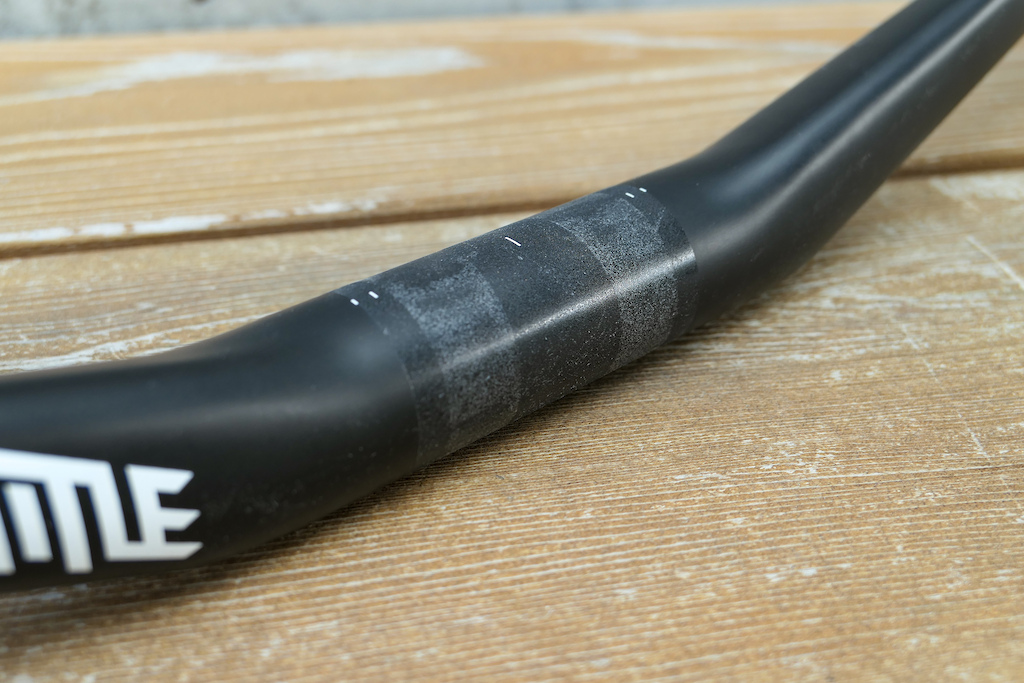
Specifications
The Form Carbon 35 bar comes in 25 or 35mm rise options with a stock width of 800mm and a matte black finish. It also houses a massive clamping surface area of 87mm that’s wide enough for Title’s direct mount DH stem.
In terms of angles, the Form Carbon 35 is a touch more relaxed with a 5-degree upsweep and 9 back.
The specified stem clamping force is listed at 6Nm but there are no specifics listed for the bar clamp controls. Thankfully, we never experienced any grip slippage or concerns for needing high clamping torques on the Form Carbon 35.
Price and Weight
The Form Carbon 35 bar is incredibly light at under 200g. When cut down to 770mm, our 35mm rise ample weighed 190g. The 25mm rise is claimed to be a hair lighter as well (2g less at full length).
Cheap, light, strong – pick two, right? That’s a common crossroads customers face and the Form Carbon 35 lives up to that pickle because it’s the most expensive of the three (taking into consideration pairing the bar with the stem from their respective brand).
Ride Impressions
For such a lightweight handlebar with a wild looking shape, there’s nothing perplexing about the ride quality. The Form Carbon 35 is neither too stiff or overly soft. It has a Goldilocks feel for aggressive riding and didn’t fatigue my hands or arms over the course of long days either.
Typically, I prefer an 8-degree backsweep bar cut to 770mm when using a 35mm length stem for bikes with head angles around 63-64 degrees. The 9-degree backsweep of the Form put my hands in a comfortable position, slightly further back towards the steering axis. That seemed to slow the steering and take some pressure off of the front wheel compared to the 8-degree options when installed on the same bike. Moving to a 40mm stem could be worth exploring if that bothers you.
+ Lightest of the three by a solid margin.
+ Wide clamping surface makes it compatible with DH stems.
+ EFBE TRI-Tested.
– 9-degree backsweep might not suit riders who prefer short 35mm-length stems
– A raw finish would be appealing to view the construction
How do they compare?
Can you notice the difference in the round, oval, and box-shaped cross sections? A blind test would be an interesting one, but if I had to take a stab at the vertical flex in each one (on a scale of 1-10, softest to stiffest) I’d give the We Are One Da Bar a 4. OneUp’s Carbon Bar would be around a 6 and Title MTB’s Form Carbon 35 would be close by at a 7. For reference to another popular bar not in the test, Deity’s Skywire Carbon 25mm rise, I’d give that a 9 as it’s one of the stiffest bars I’ve ridden.
When it comes time to choose one of these, you’ll probably think about cost first. We Are One’s proprietary Da Bar requires its own stem, driving up the total cost and may sway you if your current component is still shiny.
Secondly, I’d consider which type of bike you’ll be installing it on, how aggressively you ride, and how much you weigh. If you’re riding a short travel bike and want to maximize comfort, the softer bars could suffice. Keep in mind, the narrower you cut them, the less flex they will inherently have too.

